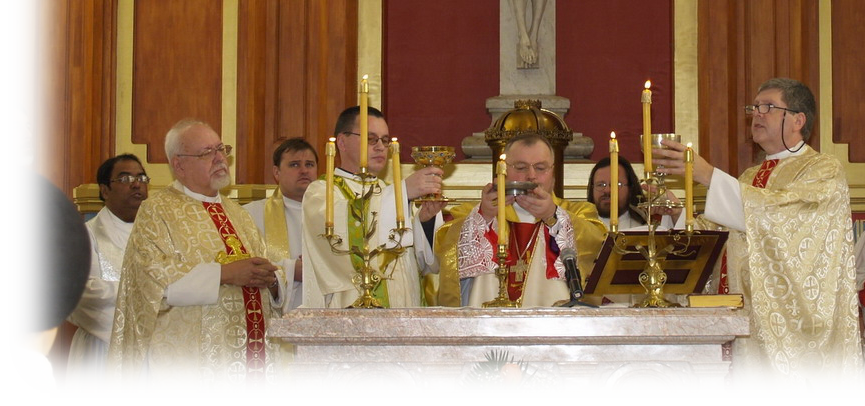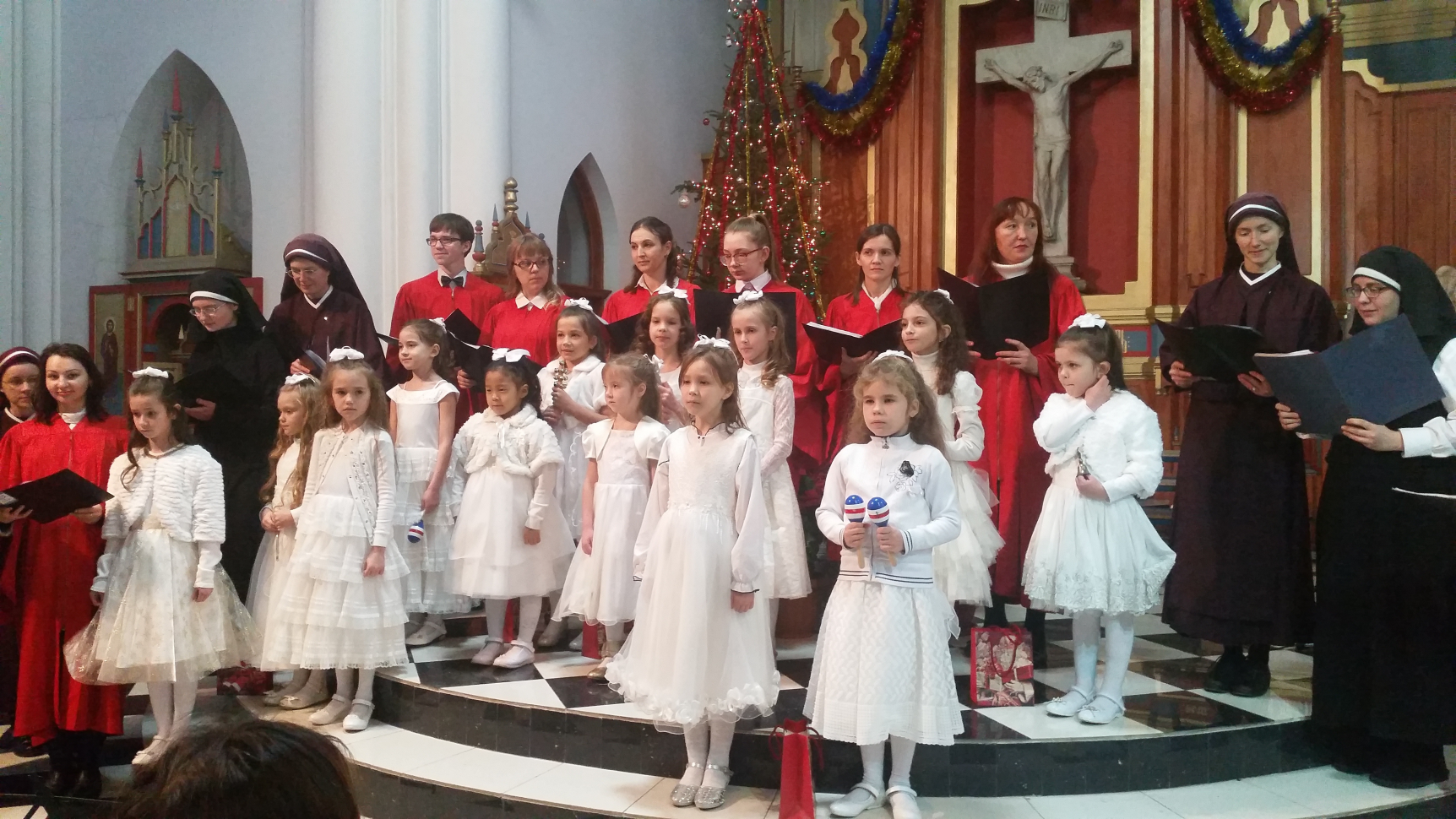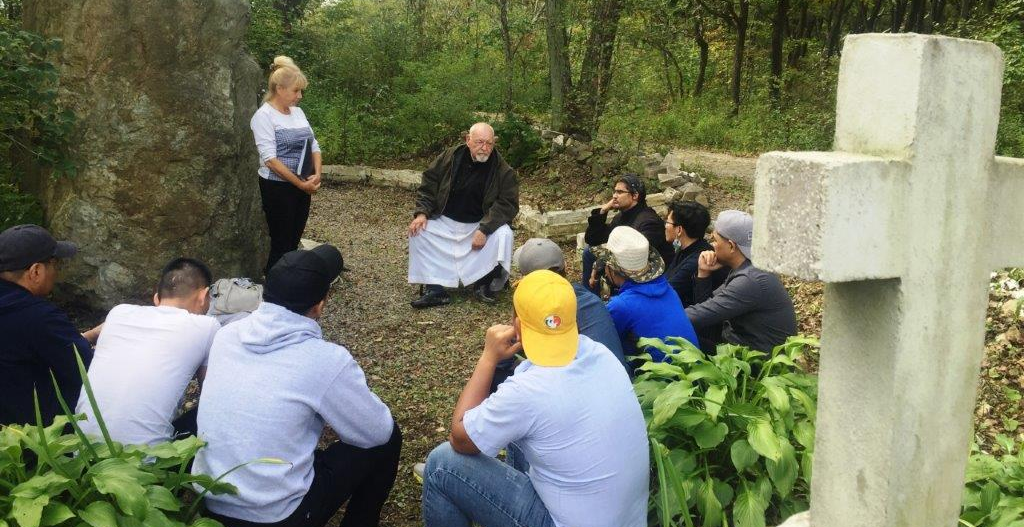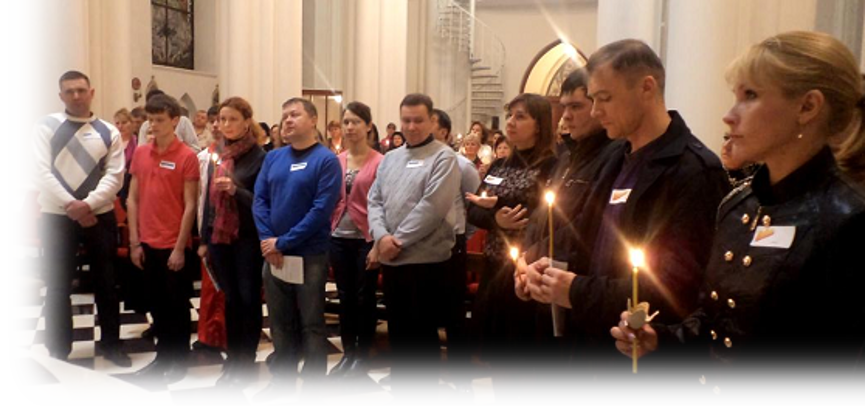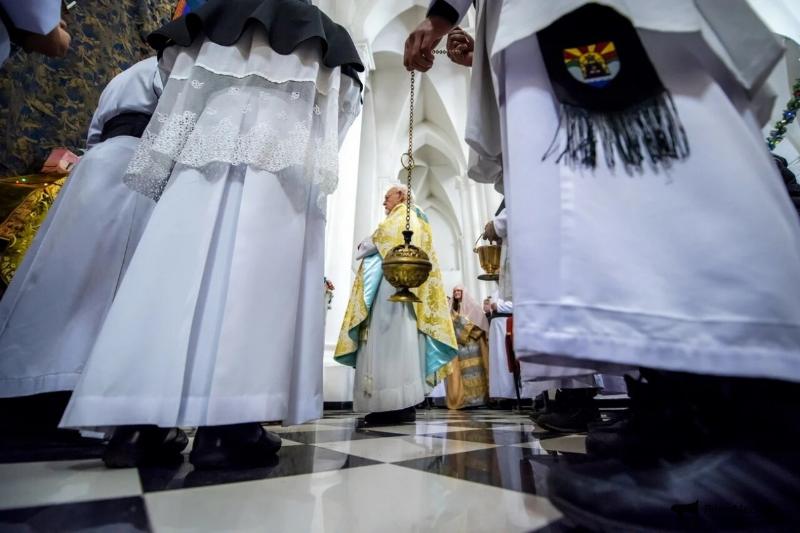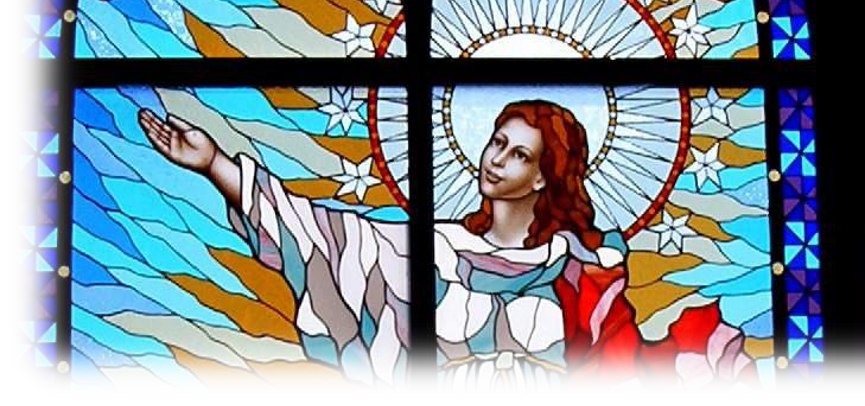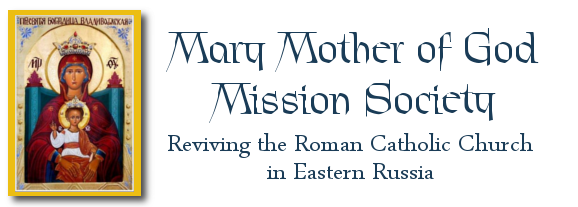The book Canonicorum regularium sodalitates (“Communities of Canons Regular”) is a series of articles from the jubilary album of the Canonical order published at Stift Vorau, Austria, in 1954 and edited by Pius Fank, C.R. The occasion was the 1600th anniversary of the birth of St. Augustine.
Here we present only one chapter. The book contains chapters on each of the congregations of Canons Regular that existed in 1954, and there are photographs showing the habits, churches, and activities of the various communities. If you need the other materials, please ask us for them. Meanwhile, since 1954 there have been new foundations of Canons Regular.
The book is somewhat dated, coming as it did before Vatican II, but it gives an excellent summary of the life and principles of the Canonical Order.
Chapter III
Dr. Karl Egger, C.R.L.
Canons Regular differ from other Orders in so far as they have no founder of their own: they are the outcome of a living organism of the Church and for this reason their institution is rather more flexible and less uniform especially with regard to the religious habit and internal constitution.
Toward the end of the period of the primitive Church some clerics grouped themselves together about Episcopal churches and followed a certain type of “common” or “religious” life. It was, in fact, to be expected that the Church, emerging victorious from its long struggle with the Roman Empire and fully occupied in consolidating its internal organisation, should have at least a part of the clergy embracing the ideal of cloistral discipline and renunciation; an ideal already put into practice by monks who at that time were almost exclusively lay-religious. Clearly, in the case of these clerics, we cannot unreservedly apply the modern juridical concepts concerning religious which are now to be found laid down in Canon Law. It is sufficient to realize that the three vows of poverty, chastity and obedience were expressly made only at the time of the Mendicant Orders, however, there is no doubt that we can discover at that early period the essence of the religious life viewed as a “common” life with the renunciation of personal property on the part of everyone and an intimate bond existing between superiors and subjects.
Apart from the Premonstratensian and Crosier Canons who have had a historical development of their own. Canons Regular since the XII century have been known as Augustinian or Austin Canons taking their name from St Augustine, the great Doctor of the Church, for he realized in an ideal way the common life of the Clergy, and because from that time the Canons adopted the “Rule” of Augustine.
The title “Canonici Regulares” is the Latin name whose origin can be traced back to the time of the Gregorian Reform when the word “Regulares” was added to “Canonici”. The word “Canonicus” as an ecclesiastical term was met with for the first time in St Basil and in the decrees of the Council of Laodicaea; originally it meant a cleric who had been appointed and was living according to the sacred “canons” or rules and distinguished him from clerics who were called “vagants” or those attached to a private church without a determined relationship to the Bishop. It is understood in the same sense in a canon of the Council of Clermont, 535 A.D., which ruled that those priests who are not “Canons” and who dwelt in the scattered private oratories, were to return to the Cathedral at least on the “greater” feast days. St Boniface, the Apostle of Germany, in a letter to Pope Zachary stated that he was obliged to help only the Bishops and the priests who were “Canons”. After a time however, the term “Canonicus” automatically came to be applied to clerks who lived in Monasteries around the Cathedral or in Collegiate churches, but the uncertainty of the term remained for a long time up to the XIth century.
From the IVth to the middle of the XIth century, the communities of Canons were established exclusively by zealous Bishops. The first who successfully united the clerical state with the monastic observance was St Eusebius, Bishop of Vercelli. This way of living was also established by St Zeno, Bishop of Verona. But it was under St Augustine that the “canonical life” reached its apotheosis. From the time of his elevation to the episcopal see in 395 A.D., he changed his episcopal palace into a monastery for clerics and established the essential characteristics-the common life with renunciation of private property, chastity, obedience, the liturgical life and the care of souls: to these can be added two other characteristics typically Augustinian—a close bond of brotherly affection and a wise moderation in all things. This spirit permeates the whole of the so-called Rule of St Augustine which at least in substance can be attributed to the Doctor of Africa.
The Invasion of Africa by the Vandals destroyed the Augustinian foundation but we can deduce it as almost certain that it took refuge in Gaul. Furthermore we find in the Vth century at Aries, a Julius Pomerious who originated from Africa and who was a faithful disciple of Augustinian thought and was an Abbot or superior of a community of clerics. His teaching on the renunciation of private property on the part of clerics of the common life is to be found in the second volume of his work “De Vita Contemplativa.” Among other sponsors of the common life we can mention St Gregory the Great and St Caesarius of Aries although their interest necessarily centers more on the monastic than on the clerical side of the life.
At the end of the VIth century there commenced a period of decadence in discipline and the disappearance of the idealism of the earlier period. Only towards the end of the XIth century can we find a rebirth of the old spirit and a renewal in the health of the religious life which can be traced to a certain extent to the reformatory movement of Cluny. This period of deterioration had its effect also on the canonical life particularly in regard to the renunciation of private property.
St Chrodegang, Bishop of Metz (742-766 A.D.), composed a rule for the Canons of his cathedral. This was the first formal rule of the Order, which enlarged and made more general in scope was received by other chapters of Canons. The cloistral observance is described there in some detail as is found in the case of monks. High walls separate the Canonry from the exterior world. Neither woman nor layman may enter the house without permissions of the Superiors. All meals are to be taken in common in the Refectory during which a pious book is to be read. During the day the canons must perform manual works conducive to both bodily and spiritual health. At night they must sleep in a common dormitory each in a small cubicle separated by wooden partitions. These occupations of a rather more material character are intersperced with activities of a spiritual nature in the form of liturgical services—the Holy Sacrifice of the Mass and the Divine Office. After Prime, the liturgical morning prayer, the Canons gather together in the Chapter house to accuse themselves of minor faults and to receive useful help in amending them so as to tend to an ever higher standard of holiness in the daily work.
As regards the question of private property the holy Bishop of Metz was obliged to take into account the situation existing at that time and make certain concessions to his Canons on this score, nevertheless he wished to lay down as a principle the old ideal of the canonical life, thus we read in his rule “…but if, on the other hand, anyone wishes to associate himself with the Canons and with a desire for perfection wishes to renounce all his private property, then the bishop will provide for all his necessities in order that he may fully realize his ideal which has been inspired by God.”
In 816 A.D. with the support of the emperor Louis, a synod was called at Aix-la-Chapelle in which was promulgated a new canonical rule for the whole of the kingdom of France while at the same time was extended to other regions especially central Italy. In this rule, the claustral life is enlarged and explained in detail yet it showed even more indulgence than St Chrodegang in the question of religious poverty.
Clearly neither one nor the other of the rules could contribute a positive element towards the re-organization of the canonical institution. The first steps towards the dissolution of the claustral communities of Canons was the permission, given by certain bishops, of administering capitular wealth when formerly the administration of all the church property was reserved to the Archdeacons. Thus separate administration once obtained led to the distribution of the revenues to each member.
The movement for reform coming from Cluny, together with Pope Clement II and the Holy See, through which it had such a far reaching effect, marked the beginning of the most important period of the Order of Canons Regular in which the Order flourished as never before and reached great heights of achievement. This renewal of life in the institution was promoted especially by the burning zeal of Hildebrand—the future Gregory VII — and by St Peter Damian. The first attempts at reform were undertaken at the Cathedral of Lucca (1048), at Atino (1056) and at Florence (1058). But it was in 1059 A.D. that the supreme authority of the Church in a Lateran Synod (April 20th) sanctioned this reform for the Canonical Order. The speaker Hildebrand connects the decadence of this ancient body, which originated during the time of the Fathers of the Church, with the fact that it was living accord-speaking full of contradictions. Therefore it was for this reason that he demanded the Synod in Order that the Rule could be thoroughly examined and amended where necessary, the assembly as a matter of fact condemned those chapters of the rule of Aix-la-Chapelle which were contrary to the primitive observance of the Order. and obliged those who belonged to this “special state of the Canonical Life” to return to the form of “Apostolic Life” in which all things were prefectly shared in common.
Thus from this Synod it can be deduced that on the one hand there was a reform of a pre-existing religious institute and in no way the foundation of a new Order as some try to maintain; the rule of Aix-la-Chapelle was by no means entirely rejected but merely corrected. While on the other hand, the Synod did not impose on the Canons a determined rule but allowed them full freedom to regulate their own claustral life according to their own statutes provided that these were in accordance with the spirit of the reform.
However, this reform instituted by the Lateran Synod embraced only one part of the Canonical body, for the new arrangement of the canoncial benefices had already made such developments as to make a return to the primitive claustral observances practically impossible. Reading certain portions of St Peter Damian, one can find an echo of the controversies provoked by this new state of affairs and thus came the division; those who embraced the reform were called “Canons Regular”, while the rest were called “secular Canons” or simply “Canons”. The Canons’ Regular then took an unexpected development. The austerity of the claustral life, the splendor of the sacred functions, the exemplary ministry which shoed itself so profitable in both the spiritual and cultural spheres, edified the ecclesiastical authority and the faithful to such an extent that in many regions there arose a large number of new canonical foundations extending as far as Scandinavia and the Orient. Many Cathedrals were given to the hands of the Canons Regular, the more important being the Basilica of St John Lateran; the Cathedrals of Perugia, Gubbio, Fane, Citta di Castello in Italy; Salzburg, and Gurk in Austria; Saragossa, Roda, Pamplona, and Lerida in Spain: Pamiers, and Comminges in France.
In the neighboring districts close to an Abbey or Priory there used to exist lesser religious houses especially parishes, which were united to the Abbey as their Motherhouse and participated in the same chapter. This historical development can be attributed to the fact that individual chapters existed as autonomous units and that the Order was never under a central government-which perhaps was not even desired. In order to meet this deficiency of a centralized government, the Supreme authority of Holy Mother Church intervened more than once, ** desirous was she to maintain the regular observance. The IVth Lateran Council convoked by Innocent III in 1215, prescribed that Canons Regular and Benedictines should hold Provincial Chapters every three years and that in these Councils certain superiors should be elected as Visitors, whose duty it was to visit in those three years the houses of a determined region (Province).
In the following century the Holy See proceeded to a further detailed reorganization of the Order. For this purpose. Pope Benedict XII promulgated in 1339 the Apostolic Constitution “Ad decorem Ecclesiae, Sponsae Dei” which contained certain provisions for the acceptance and education of young religious, for the celebration of the Divine Office, for various duties in the cloister, for the food and clothing, for the administration of property, for studies, etc, and enjoined the convocation of Provincial Chapters every fourth year, together with the required canonical visitations of the monasteries. It was thus the whole Order came to be divided into Provinces, which nevertheless, had nothing in common with the religious provinces which are now described in the code of Canon Law.
The unhappy times of the Western Schism and the custom introduced into a number of countries of bestowing the monastic revenues on dignitaries, ecclesiastical and lay, caused both the internal and external decadence of many canonical communities.
But happily, the Order had within itself the necessary ability and vitality to react against this malady which had introduced itself. Thus arose in the Canonical Order new organizations for reform, namely with a centralized government, its own constitutions and a mode of life generally marked by a strict austerity. Some of the congregations went as far as surrendering the primitive autonomy of their monasteries.
One of the first and most important of these congregations was that of Windesheim. Its spiritual Father was Gerard Groote, the reformer and mystic of the Low Countries. This Congregation was founded in 1386 and was approved by Pope Boniface IX in 1395. Its internal constitution was wisely tempered by retaining the ancient autonomy of the monasteries together with the centralization maintained by the more recent congregations. Each monastery reserved the right to elect its own Prior or Provost. Every Canon Regular belonged to that house in which he made his vows but he could be transferred to another house in the interest of the common good of the Order (subsidium Ordinis), or for any other grave reason, at the same time he continued to belong to his own monastery. During his stay in the other house he would enjoy all the rights of a member of the chapter in that house. The superiors met regularly at the Motherhouse of Windesheim in Holland for the General Chapter which was a legislative assembly of vital importance. The control of the eighty monasteries was managed by means of a canonical visitation which made a thorough scrutiny in order to eradicate rigorously any abuses which may have been introduced. This important congregation spread to all the German speaking countries and became extinct only at the beginning of the last century as a result of the secularization which took place at that time.
The Lateran Congregation and Renon (Saint Savior) will be discussed later.
The Congregation of St George in Alga. (Venice). This was a congregation of Canons of the common life rather more austere but without the formal profession of vows until 1570 when they began to make solemn vows. To this congregation belonged Pope Eugene IV and St Lawrence Justinian.
The Congregation of France. The Prior of the famous Abbey of St Genevieve in Paris, Charles Faure, supported by Cardinal de La Rochefoucauld united nearly all the French Abbeys and Priories into one congregation. Their internal constitution was centralized with Abbots and Priors holding their tenure of office for a period of three years. This congregation died out as a result of the French Revolution.
The Congregation of Our Savior of Lorrain. Founded by St Peter Fourier, a Canon Regular of the ancient Abbey of Chamouzey. Tills congregation was principally concerned with the ministry of souls and education of youth.
The Congregation of the Holy Cross of Coimbra. This congregation received its name from the monastery dedicated to the Holy Cross of Coimbra, Portugal, where St Anthony of Padua, then called Ferdinand, lived for ten years as a Canon Regular. In 1527 various Portuguese monasteries grouped together with that of Holy Cross and resulted in this congregation.
Of the ancient and primitive rules, especially of St Chrodegang and Aix-la-Chapelle, we have already spoken at some length. At the time of reform these came to be accepted in some monasteries of Canons Regular but with certain modifications and amplifications, especially from the Rule of St Benedict. While in other monasteries there arose completely new rules as for example the “Regula Canonicorum” of St Gregory VII and the “Codex Ottobonianus” 38 in the Vatican Library. More widespread was the “Regula Portuensis” (of St Mary in Porte near Ravenna); the rule of Marbach in Alsace and that of St Victor in Paris. In particular rules were written for the decorous carrying out of the Sacred Liturgy, e.g. the “Ordines Claustrales” which in great part are yet unpublished. Also worthy of note is the “Ordo Officiorum Ecclesiae Lateranensis” first written in 1145 by one Bernard, Prior of the Canons Regular of the Lateran, for his community which insured the proper fulfillment of the divine service in the Cathedral of the Supreme Pontiffs.
St Augustine’s doctrine concerning the common life of clerics, contained principally in two of the Saint’s sermons was continually repreduced in the ancient rules of the Canons Regular. In fact no Father of the Church has inculcated this form of life with greater effect. Moreover, in the XIth century, the works of St Augustine were diffused widely, especially those which supported ecclesiastical reform of Gregory VII. Thus it was not surprising that the rule of St Augustine, which together with other rules such as those of St Isidore and St Fructuosus, were used from the end of the VIIth century as spiritual reading especially in the monasteries of monks of Gaul and Spain, nor was it remarkable that they should have been introduced into the monasteries of Canons Regular. Furthermore, toward the end of the XIth century we find it among the Canons Regular in France, and in the century in Germany, Austria, Italy, and elsewhere. In the beginning it was often joined to already existing canonical rules and gradually came to replace them. Thus in the course of the XIIth century it became the official rule of the Order. One of the most zealous promoters for its introduction was Gerhoh, Provost of Reichersberg in Austria.
With regard to spirituality, the Canons Regular had two schools in particular whose importance and influence extended far beyond their own order.
1. The School of St Victor. Among the principal representatives of this school, which was influenced by St Augustine and the Pseudo-Denis, are Hugh, Richard, Adam, Accord, Thomas Callus, The created universe, the events of history and particularly Sacred Scriptures, contain a “divine nucleus”. This “nucleus” is perceived by intuitive meditation from which one arises to affective contemplation which is the unique consideration of Truth when one is free from the “fire of passions”.
2. The School of Windesheim. (Devotio Moderna). This school shows a new way towards union with God – a simple way – far from the philosophy of the scholastics; it teaches how one can find Christ in the intimate recesses of the soul; for this spiritual experience the soul must prepare itself by meditation on the humanity of our Lord. In its day, this was considered as something novel whence arose the term “modern devotion” which was given to this method of practical asceticism. Small penances, examinations of conscience, a new method of meditation based on the imagination, will and intellect, are the ascetical means used by those who follow its teaching. This “modern devotion” also spread to the new Latin countries and came to be known in Spain through St Ignatius of Loyola. It was Thomas Hemerken of Kempen (Thomas a Kempis), a Canon Regular of Windesheim, who brought out the principal work of this new spirituality-the famous “Imitation of Christ” which from that time, became the heritage of the whole of Christianity.
From the earliest times the Canons Regular were dedicated to the apostolate, ordinary and extraordinary. Often the foundation of a monastery coincided with the assignment of parishes. For this reason the communities of Canons Regular have always been found in close contact with their respective dioceses and with the faithful.
They also deserve mention in the field of the extraordinary apostolate. It was a Canon Regular, St Vicelin, who preached the gospel to the Vagriers, a pagan tribe of the Vends. Meinhard carried the good tidings to the Latvians. The first missionaries in the Congo belonged to the Portuguese Congregation of St John the Evangelist, who also sent apostles to Ethiopia (Abyssinia) and to India.
Their corporal works of mercy extended to an even wider field. Nearly all their monasteries had an hospice or guesthouse, where the poor, sick and pilgrims could be looked after. There arose likewise, for a work, by no means less important, the Canons Hospitallers. To this group belong, among others, the Canons Regular of the Great St Bernard, of St Anthony and of the Holy Spirit. Finally and not without importance were contributions made by the Order towards science and the fine arts, many abbeys existing for long periods as great centers of culture. The religious of the violently oppressed monasteries could have been able very often to refer to similar cultural worth as the Canons of Beyharting who could say to the commissioner of repeal in 1803: “What we got as a desert we give back as a garden.”
Out of the list of distinguised Canons Regular except those already mentioned learned men of the School of St Victor special attention must be caned to the following ones: the Italians Mark H. Vida (+1566), neo-Latin epic poet and theorist of poetics, of far reaching influence; the Abbot General John Chrysostomus Trombelli (+1784), theologian and historian, and the still living Lateran Abbot Joseph Ricciotti; the Spaniards Cardinal Aegidius Albornoz (+1367), Canon of Saragossa, “the greatest political genious whom the Spanish nation had born” (Pelayo), the second Founder of the Vatican State, and Benito Arias Montanus (+1598), “a giant of strength and learning”, editor of the Antwerp Polyglot Bible; the Bask Martin de Azpilcueta Navarrus (+1586), Canonist and Moralist, spiritual adviser of three Popes; the Portuguese Miguel Carlos da Cunha (+1799), Prior General and Bishop of Coimbra who had to languish for eight years in prison because of his immovable defence of the rights of the Church against the encroachments of the almighty Minister Pombal; the Frenchman James of Vitry (+1240), preacher of the crusade and author, John Bapt Santeul (+1697), one of the best poets of Latin hymns, Bertholomew Aemilia (+1673), Canon of Pamiers, popular preacher of repentance who was called “the Grignion de Montfort of Languedoc”, and not at last Alan of Solminihac (+1659), founder of the Congregation of Chancelade, renovator of the religious life among the clergy and the people—the canonical inquest for the beatification is now in progress—and also successor of St Vincent de Paul in fighting Jansenism; the Englishmen William of Newbury (+about 1198), historian, and the energetic and ethical Nicholas Breakspeare, from 1154 till 1159 Pope as Hadrian IV, the only of the English nation; the Netherlands Arnold of Tongern (+1546), writer, Gerlach Petersz (+1411), Canon of Windesheim, mystic, called “the second Thomas of Kempen”, Provost John Busch (+1479), famous reformer of the order of far reaching influence, John Mauburnus (+1501), leading prepresentative of the Devotio Moderna, and finally the great humanist Desiderius Erasmus of Rotterdam (+1536), who took up his new duties in the cloister Stein near Gouda in 1487, from 1493 he lived outside the cloister but remained a man of the order up to his death; the Germans Mangold of Lautenbach (+after 1103), celebrated by his contemporaries as “teacher of the modern teachers”, provost of Marbach in Alsace where about 1150 the Canon Sintram wrote the famous Code of Rules (now in the seminary in Strasbourg), Gerhoh of Reichersberg (+1169), a great theologian, a brave defender of the rights of the Church and untiring pre-fighter for the reform of the discipline of the Church, Andrew of St Mang in Regensburg (+1438), “the Bavarian Livius”, Michael Kuen (+1765), provost of Wengen, important historian, Eusebius Amort (+1775), Canons of Polling, one of the many sided learned men of his time, fellow-founder of the equiprobabilism in moral theology, John Ignatius Felbiger (+1787), provost of Sagan, renewer of the Catholic school, and finally Francis Toepsl (+1796), provost of Polling, celebrated by his contemporaries as “gemma Praelatorum”, admired as “Universalgenie” and by prince-abbot Marin Gerbert called a “living library”, who wrote 60 folios (now as manuscript in the National Library in Munich) about the “Scriptores Can. Reg. S. Augustini”.
The saints of the Order are: Israel (+1014), Canon of Doratum and his disciples Theobald (+1070) and Walter (+1070), Abbot of Lesterp; Gaucherius (+1060), Prior of St Jean d’Aureil; Peter (+1080), Provost of Pebrac; Bernard of Menthon (+1081), founder of the Hospital of the Great St Bernard, patron of Alpinists; Yvo (+1117), Bishop of Chartres, one of the greatest Canonists in the Middle Ages; Raymund (+1126), Bishop of Roda-Barbastro in Splain; Guiraudus (+1123), Bishop of Beziers; Olger (+1137), Archbishop of Tarragona, reformer of the Spanish Clergy; Kield (+1150), Provost of Virbog in Denmark; Vicelinus (+1154), Apostle of the Wandes, founder of three monasteries of Canons, Bishop of Oldenburg and his blessed disciples Volker of Segeberg (+martyr 1132) and Ditmar of Neumunster (+1152); Guerinus (+1158), Cardinal-Bishop of Palestrina; Ubald (+1160), Bishop of Gubbio, reformer of the clergy; Theotonius (+1166), first prior of the “Holy Cross” at Coimbre; Laurent (+1180), Archbishop of Dublin; Gilbert of Sempringham (+1198), great ascetic saint, founder of the double monasteries of the Gilbertines which were very popular in England; Thorlak Thorhallson (+1193), Abbot of the Canons Regular, later Bishop of Skalholt, first Saint of Iceland; Menard (+1196), Canon of Segeberg, Apostle and Bishop of Livonia; William Tempier (+1197), Bishop of Poitiers; William (+1203), Abbot of Ebbelholt in Denmark, who used to feed 100 poor every day; Albert (+1214), Canon of Mortara, Bishop of Vercelli, Patriarch of Jerusalem, organizer of the Carmelites; Fulcus (+1224), Bishop of Pavia, a sacred orator; John (+1379), Prior of Bridlington; Peter Arbues (Martyr +1485), Canon of Saragossa, a calumniated member of the Spanish Inquisition; Laurent Justinian (+1456), first Patriarch of Venice; John of Osterwijk (+1572), one of the martyrs of Gorkum, in Holland; Peter Fourier, Rector of Mattaincourt in Lorraine, whose social action was remarkable; he also founded the Canonesses of Our Lady and the Congregation of Our Savior.
Honored as “Blessed”: Heldemar (+1097), founder of the monastery of Arrouaise (France); Lambert (+1123), first Provost of Neuwerk, near Halle; John (+1130), Bishop of Therouanne; Erkenbert (+1132), founder and first provost of Frankenthal, near Speyer; Rudhard (+1150), first Provost of Au in Bavaria; Jean de la Grille (+1163), Bishop of St Malo; Hartmann (+1164), Provost of Klosterneuburg, Bishop of Brixen, founder of Neustift; Pontius of Sixt (+1178), Abbot; Martin of Leon (+1229), Canon of St Isidorus at Loon, an interpreter of the Holy Scriptures; Bonifacius (+1243) and Emmerich (+1313), Bishops of Aosta; John Ruysbroek (+1381), the “doctor extaticus”, first Prior of Groenendaal, a man of high mysticity; Stanislaus Soltys (+1489), Canon of Cracow; Archangel Canetoli (+1513), Canon at Gubbio, an apostle of charity; Charles-Mary Bernard, John-Francis Bonnel de Pradal and Claudius Ponse, Canons at Paris (+1792), victims of the French Revolution.
Apart from the normal consumption of energy which is proper to every human institution, the Order of Canons Regular underwent the gravest of losses as a result of the so-called Protestant “Reformation”, the French Revolution and the Secularization of the last century, losses which can never be replaced. However, we are convinced that the Order has a vital mission to accomplish in our own times [emphasis is Fr Egger’s]. With such a great and glorious past, it could never be content to rest on its laurels. With a new energy and power it must encounter the problems of the world today, and effectively cooperate in the re-Christianization of modern society. This then, in our opinion is the profound menaing of this jubilee celebration in honor of St Augustine.
